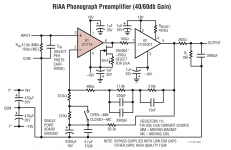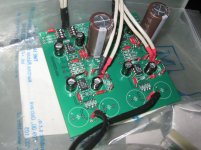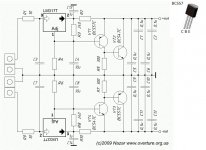I'm making this; Op-amp Based RIAA Phono Preamp for MM and MC Phono Cartridges. Just ordered the parts but I have no idea of how good it is! It can be made really cheap and the op amp is pretty good and its inexpensive compared to others! I am going to put it inside the tonearm since its that small!
This one can be built with LT 1115, or LT 1028, stunningly simple and good. IC based RIAA-s cannot get nuch better than this one. I even have the PCB design for it somewhere.
http://www.linear.com/product/LT1115
http://www.linear.com/product/LT1115
Attachments
Last edited:
Hi,
it might have helped if You´d defined the task.
What will be the intended useage?
Do You need the Phono-stage as amplifying stage feeding into a dedicated line-Level preamp, or shall it be a standalone solution (with volume control).
Is it intended for MM or MC cartridges, or both?
Do You have a certain pickup cartridge in mind?
What´s Your budget and what quality do You want to achieve?
The Qs are meant to get an idea of how much flexibility and complexity of the circuit will be required and of course to give a hint about the required budget.
If a certain MM-pickup is set as source a simple single gainstage with fixed parameters like the one from #2 will suffice.
If You want to be open to cartridge choice the phono stage needs to have some means to adjust for cartidge loading.
The circuit of #2 will be rather useless for MC pickups even if it has a witch for that.
MC-amplification requires at least two gain stages, similar to the circuit from #4 (which btw. is the phono stage of Bauer).
Then one could think about more flexibility options, like e.g. a balanced connection from the pickup to the amp-input, which improves on noise immunity.
In this thread starting from #62 a one-fits-all top-notch balanced-in phono stage is discussed.
The Clearaudio Balanced Reference is one of several commercial implementations of that circuit.
Pros are:
- almost any pickup on the market can be served
- load impedances switchable
- gain can be chosen for low output MC pickups to high output MMs (from 0.15mV to >5mV nominal output voltage)
- single ended or balanced Input connection
- DC-servo, resp. 20Hz subsonic filter
- RIAA, RIAA/IEC and RIAA/Neumann equalization options
- very linear amplitude response, better than most others without matching or trimming of parts
- optional volume control
- optional balanced output
- easy to build without trimming or matching of components
- Beginner friendly (single layer PCB possible, layout data available)
- Power supply quality requirements are rather low
- parts sourceable from one supplier (or at least very few suppliers)
- extremely capable phono stage that lets even the most expensive pickups shine
- very priceworthy
cons are:
- priceworthy doesn´t necessarily mean cheap. Cost of parts (wo casing) will be ~200-300$
You find a description and links on my Website
Follow the link to the HiFiForum RP1.
The RP1 is a very nice and stylish stand-alone implementation of the phono stage.
jauu
Calvin
ps. the thread would be better located at the Analog Source forum.
Maybe You´d like to ask a Mod to move it.
@dawg65:
The LT1010 is only a Buffer intended to supply for sufficient current, as the feedback network (especially for MC) becomes quite lowohmic at elevated frequencies.
The LT may be replaced by any other Buffer, discrete or integrated (see BB´s BUF634 et al).
it might have helped if You´d defined the task.
What will be the intended useage?
Do You need the Phono-stage as amplifying stage feeding into a dedicated line-Level preamp, or shall it be a standalone solution (with volume control).
Is it intended for MM or MC cartridges, or both?
Do You have a certain pickup cartridge in mind?
What´s Your budget and what quality do You want to achieve?
The Qs are meant to get an idea of how much flexibility and complexity of the circuit will be required and of course to give a hint about the required budget.
If a certain MM-pickup is set as source a simple single gainstage with fixed parameters like the one from #2 will suffice.
If You want to be open to cartridge choice the phono stage needs to have some means to adjust for cartidge loading.
The circuit of #2 will be rather useless for MC pickups even if it has a witch for that.
MC-amplification requires at least two gain stages, similar to the circuit from #4 (which btw. is the phono stage of Bauer).
Then one could think about more flexibility options, like e.g. a balanced connection from the pickup to the amp-input, which improves on noise immunity.
In this thread starting from #62 a one-fits-all top-notch balanced-in phono stage is discussed.
The Clearaudio Balanced Reference is one of several commercial implementations of that circuit.
Pros are:
- almost any pickup on the market can be served
- load impedances switchable
- gain can be chosen for low output MC pickups to high output MMs (from 0.15mV to >5mV nominal output voltage)
- single ended or balanced Input connection
- DC-servo, resp. 20Hz subsonic filter
- RIAA, RIAA/IEC and RIAA/Neumann equalization options
- very linear amplitude response, better than most others without matching or trimming of parts
- optional volume control
- optional balanced output
- easy to build without trimming or matching of components
- Beginner friendly (single layer PCB possible, layout data available)
- Power supply quality requirements are rather low
- parts sourceable from one supplier (or at least very few suppliers)
- extremely capable phono stage that lets even the most expensive pickups shine
- very priceworthy
cons are:
- priceworthy doesn´t necessarily mean cheap. Cost of parts (wo casing) will be ~200-300$
You find a description and links on my Website
Follow the link to the HiFiForum RP1.
The RP1 is a very nice and stylish stand-alone implementation of the phono stage.
jauu
Calvin
ps. the thread would be better located at the Analog Source forum.
Maybe You´d like to ask a Mod to move it.
@dawg65:
The LT1010 is only a Buffer intended to supply for sufficient current, as the feedback network (especially for MC) becomes quite lowohmic at elevated frequencies.
The LT may be replaced by any other Buffer, discrete or integrated (see BB´s BUF634 et al).
Last edited:
Check this one: Texas Instruments Application Note AN-1651. Just built it and it´s pretty low noise and sounds good, well at least to my ears.
What do you think now about the preamp you built? Have you got the opportunity to compare it to some other preamp? Could I see some layout photo?
I would like to use such a preamp with a Luxman PD-262 with a AT-95EB cartridge.
This one can be built with LT 1115, or LT 1028, stunningly simple and good. IC based RIAA-s cannot get nuch better than this one. I even have the PCB design for it somewhere.
LT1115 - Ultra-Low Noise, Low Distortion, Audio Op Amp - Linear Technology
I want to share my experience regarding the project our colleague from Hungary mentioned
I built this phono preamplifier and I was happy with it from the beginning. I tested several components and the final version according to my ears, is the best. I used PRP 0.25W resistors, NO 470uF caps, the 1uF caps are 10 uF Black Gate F series (better than Silmic II), C0G capacitors in the RIAA net, NO 4.7 uF film cap bundled with the 2200 uF one, 2200 uF/16V Silmic II, (better than Black Gate standard).
Before getting to this version I used Takman REY resistors. The sound seemed dull to me. I prefer the PRP's.
I also attached the power supply I am using. The series resistor is 36R
Over all, I think it is a great sound.
Attachments
You might want to check Elektro’s Supra RIAA amplifier. They use 4 opams in parallel to further reduce noice.
You might want to check Elektro’s Supra RIAA amplifier. They use 4 opams in parallel to further reduce noice.
Maybe I don't understand very well, but in that project I see 8 LT1028 and the power supply is limited to 200mA. Is that OK?
Hi,
But for MM the paralleling doesn't make sense at all and even for MC one can doubt a practical advantage.
Only for very low output MCs (<0.3mV) might the parallel array give the required edge in voltage noise.
For MCs with typical and high output voltages a single LT1028 suffices to make the stage transparent noisewise.
For MMs, where not only the noise voltage counts but also the noise current, paralleling is rather counter productive and a single NE5534 will probabely show very similar noise figures at a fraction of the cost and effort.
While the paralleling of not-so-very-lownoise transistors in the Supra did make sense, I doubt that it does in the OPA-Supra for this OPAmp, in this application.
Besides, sonically I found all Phono-pres I heard utilizing LT1115 or LT1028 rather uninvolving, boring in sound (though admittedly the Layout and Supply design play a vital role here too).
jauu
Calvin
They also claim it to be MC and MM capable.They use 4 opams in parallel to further reduce noice.
But for MM the paralleling doesn't make sense at all and even for MC one can doubt a practical advantage.
Only for very low output MCs (<0.3mV) might the parallel array give the required edge in voltage noise.
For MCs with typical and high output voltages a single LT1028 suffices to make the stage transparent noisewise.
For MMs, where not only the noise voltage counts but also the noise current, paralleling is rather counter productive and a single NE5534 will probabely show very similar noise figures at a fraction of the cost and effort.
While the paralleling of not-so-very-lownoise transistors in the Supra did make sense, I doubt that it does in the OPA-Supra for this OPAmp, in this application.
Besides, sonically I found all Phono-pres I heard utilizing LT1115 or LT1028 rather uninvolving, boring in sound (though admittedly the Layout and Supply design play a vital role here too).
jauu
Calvin
Maybe I don't understand very well, but in that project I see 8 LT1028 and the power supply is limited to 200mA. Is that OK?
It is important to read and use the schematic provided in the Elektor magazine itself. The ones posted on the web is a different one. At first I was also confused by that.
The initial design is dated from 1982 where they used discrete transistors. The Supra 2.0 version is a design with opamps and is published in edition 4/2016. This version is only for MM purposes. More recently Elektor has updated the design for MC as well. I only have the Elektor issue 4/2016 so I can't comment on the MC version. In any case, the power supply in the Elektor magazine is not limited to 200 mA.
But for MM the paralleling doesn't make sense at all and even for MC one can doubt a practical advantage.
Calvin
By paralleling four opamps you further reduce the noise (of the opamp) by a factor 2. This is where the concept of the design is based on.
Of course, the cartridge will introduce high levels of "noise" as well but that is inherent to vinyl technology (ex: mechanical contact).
Last edited:
Besides, sonically I found all Phono-pres I heard utilizing LT1115 or LT1028 rather uninvolving, boring in sound (though admittedly the Layout and Supply design play a vital role here too).
This is something very subjective!
Personally I don not agree that opamps have a "sound of their own". The "sound signature" of a design can be different yes. But that's due to the complete design, incorporating all electronics (filters, etc).
Hi,
Besides, sonically I found all Phono-pres I heard utilizing LT1115 or LT1028 rather uninvolving, boring in sound (though admittedly the Layout and Supply design play a vital role here too).
jauu
Calvin
What design do you prefer?
PS
I use SUT's for MC
Hi,
@delange.
As said before for MM its not sufficient to look at voltage noise alone.
Above ~1kHz the impedance of typical MMs raise so high that current noise becomes the dominant factor.
IIrc Mr. Lindsley Hood once suggested figures of less than 5nV/sqr(Hz) and 3pA/sqr(Hz) and 1/f as low as possible to be 'transparent' noisewise.
Figures fulfilled already by a single cheap old NE5534 and from a single LT1028 with a great margin.
Paralleling LTs would only make sense for low output MCs below ~0.2mV@1kHz@5cm/s as for that application lowest voltage noise counts while current noise plays a negligable role.
@saptemari
see post #6
jauu
Calvin
@delange.
As said before for MM its not sufficient to look at voltage noise alone.
Above ~1kHz the impedance of typical MMs raise so high that current noise becomes the dominant factor.
IIrc Mr. Lindsley Hood once suggested figures of less than 5nV/sqr(Hz) and 3pA/sqr(Hz) and 1/f as low as possible to be 'transparent' noisewise.
Figures fulfilled already by a single cheap old NE5534 and from a single LT1028 with a great margin.
Paralleling LTs would only make sense for low output MCs below ~0.2mV@1kHz@5cm/s as for that application lowest voltage noise counts while current noise plays a negligable role.
@saptemari
see post #6
jauu
Calvin
Last edited:
Hi,
@delange.
As said before for MM its not sufficient to look at voltage noise alone.
Above ~1kHz the impedance of typical MMs raise so high that current noise becomes the dominant factor.
IIrc Mr. Lindsley Hood once suggested figures of less than 5nV/sqr(Hz) and 3pA/sqr(Hz) and 1/f as low as possible to be 'transparent' noisewise.
Figures fulfilled already by a single cheap old NE5534 and from a single LT1028 with a great margin.
Paralleling LTs would only make sense for low output MCs below ~0.2mV@1kHz@5cm/s as for that application lowest voltage noise counts while current noise plays a negligable role.
I'm honestly not too familiar with the behavior of MM cartridges. but thanks for the clarification.
It amazes me though that the Elektor designer wouldn't be aware of that behavior.
- Status
- This old topic is closed. If you want to reopen this topic, contact a moderator using the "Report Post" button.
- Home
- Source & Line
- Analogue Source
- RIAA preamp project


